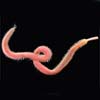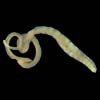Phylum Annelida
Annelids are elongated, segmented worms, with body segments typically of annular (ring-like) appearance. They are coelomate animals (they possess a fluid-filled body cavity called a coelom that separates the gut from the body wall). This coelom allows digestion to occur independently from body movement, and is also acted upon by muscles in the body wall, creating a hydrostatic skeleton that provides flexibility and great strength during locomotion. Each body segment (also sometimes called a somite or setiger) is typically very similar in internal structure to most other body segments, and is separated from the next segment by a tissue partition called a septum. Most segments contain a pair of excretory organs (nephridia), nerve cells (ganglia), blood vessels, a gut section, and genitalia and associated ducts. In the annelids, certain segments, such as the head and tail regions, are often specialized for feeding or burrowing according to the lifestyle of the worm.
The currently known 9,000 or so species in the Phylum Annelida fall into four main classes: the Archiannelida (which are very small and poorly known interstitial worms), the Hirudinea (marine, freshwater and terrestrial leeches), the Oligochaeta (marine, freshwater and terrestrial worms, including the familiar earthworms, with few bristles along their bodies), and Polychaeta (mostly marine worms named for the many bristles that occur along their bodies). Polychaete worms are by far the most diverse of the annelids, and are also the most speciose group that we encounter in San Francisco Bay. Oligochaetes also occur in the Bay, and the occasional marine leech also turns up in our samples.
|
Polychaeta
|
 |
|
Oligochaeta
|
 |
